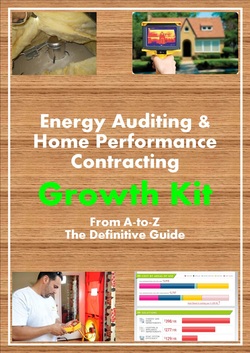Passing the BPI Exam With Energy Auditor Training
FREE BPI PRACTICE EXAMPUT YOUR HOME PERFORMANCE BUSINESS ON ROCKET FUELENERGY AUDITOR NEWSLETTERGet the only Energy Auditor Marketing Newsletter with monthly strategies and tactics to grow your home performance business.
The main topics of the BPI BA exam are listed out below. Click on a link that interests you, or you need some brushing up on to learn more on each subject.
1. Building Science Fundamentals 1a. Basic terms and definitions 1b. Principals of energy, air & moisture 1c. Combustion science 2. Buildings and Their Systems 2a. Building components 2b. Conservation strategies 2c. Comprehensive building assessment process 2d. Design considerations 3. Measurement and Verification of Building Performance 3a. Applied diagnostics and troubleshooting 4. BPI National Standards and Project Specifications 4a. Comprehensive building assessment 5. Analyzing Buildings Systems 5a. Comprehensive building assessment 5b. Appliances and lighting 6. Conduct and communications 6a. Conservation strategies |
BPI Written Exam - Section 2 Buildings and Their Systems
Ventilation systems have become more advanced, houses tighter, greater indoor air pollutants and flue temperatures lower, we need to be aware more than ever the affect of ventilation equipment on the homes we see. We need to ventilate a home to:
1. Provide fresh air for us to breathe 2. Dilute indoor air pollutants and moisture Yes, houses do need to breathe and traditionally we have relied on air and duct leakage from ANYWHERE outside to provide "fresh air." According to ASHRAE 62.2-1989, the code to which all homes were built up until a couple years ago, fresh air included attic air, crawlspace air or wall cavity air leakage which we know is dusty, polluted and not fresh air... but hey, it's outside air right? We want to build houses tight, then ventilate it right. Our ventilation systems should be reliable and predictable as the air we breathe, we want to control the amount of fresh air that is coming in, while minimizing the cost. Filters do not bring in fresh outside air or remove moisture, they just filter the air. Ventilation equipment can potentially back draft CO or cause spillage into the house. Whether it is an exhaust fan, dryer, attic fan or even an HVAC system, all can have a negative affect on the CAZ and combustion safety issues. ASHRAE is the American Society of Heating, Refrigerating, and Air Conditioning Engineers and set the standards for low rise residential ventilation in section 62.2. BPI uses an old ASHRAE 62.2 standard from 1989 for their calculations, which the Home Performance With Energy Star program follows. The National Weatherization Program uses the newer 2007 ASHRAE 62.2 standard. For the exam, you will need to know only the 1989 standard.
Fresh Air Ventilation
Whole Home Ventilators
A whole house ventilator operates just like a blower door, it sucks the stale air out of the home, forcing fresh air in through open windows. Whole home ventilators are ideal in more temperate climates like New England, whereas extreme climates like Phoenix that do not have a fall or spring season would not benefit from "natural cooling." Exhaust Only Ventilation Exhaust only ventilation (and their respective ventilation power) includes: 1. Dryers (100 - 225 CFM) 2. Range hoods (350 - 1000 CFM 3. Power vented water heaters (50 CFM) 4. Bathroom and laundry exhaust fans (50 - 110 CFM) 5. Central vacuum systems (100 - 200 CFM) If you add those up, it can be a significant amount of air that is pulled from the house to the outside, potentially creating a large negative pressure and bringing in unwanted pollutants to the home. ERVs and HRVs ERV is an energy recovery ventilator and a HRV is a heat recovery ventilator. These products are the best way to deliver fresh air ventilation at the lowest possible cost. The ERV's and HRV's bring fresh outside air into the home, but pre-condition or pre-heat it depending on the season to keep heating and cooling costs down. Attic VentilationIssues involved with ventilation equipment in attics are... THEY ARE NOT RECOMMENDED! Well, that probably won't help you pass the BPI exam but here is some information that will help further your testing knowledge and help you in the field as well. Basically any power vented fan whether it be a solar powered attic fan or electric attic fan is bad for the homeowner. What is OK is PASSIVE ATTIC VENTILATION, things like gable vents, bird venting holes, whirly birds and rigid vents.
Attic ventilation can seem to be a good thing, you cool down your attic in the summer and less heat will get into your home. Many homeowners also get told more attic ventilation will extend the life of their roof and when roofing sales people start down that path combined with homeowner speculation, too much of a good thing becomes bad. There is no documentation that attic fans actually extend the life of roofs and no documentation that they even help cool an attic. It has been proven that attic fans installed without air and duct sealing a home will pull conditioned air up from the house and into the attic. Yes that’s right, the average house has an equilivent of a 1 sq ft window open all the time from leakage connections to the attic. Where attic fans become harmful is when they start pulling carbon monoxide in from an attached garage and cause a gas water heater to backdraft or pilot lights to go out on gas appliances. Air leaks and wasting energy is fine, that can be fixed but having family become sick because of CO poisoning is dangerous and people need to be aware of attic fan side effects. Next Section2a. Building Components
2b. Conservation Strategies
2c. Comprehensive Building Assessment Process
2d. Design considerations
|

